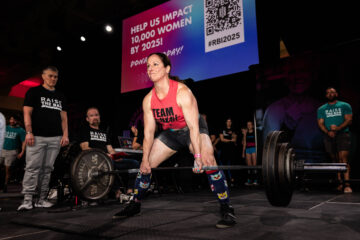10 tips to enhance inclusion of women in our teams

BY HOLLY STEVENSON, DIRECTOR OF DIVERSITY, EQUITY, INCLUSION AND BELONGING, OPTIMAE LIFESERVICES
Women in the workplace are feeling increasingly included — the last nine years of countrywide research from McKinsey bears this out. Although these hard-earned gains are encouraging, they are also fragile and require continuous and deliberate efforts from all of us to maintain and enhance them.
Of course, women are not a homogenous group as we are all too often mislabeled — we are complex, intersectional and unique. However, there are thoughtful steps that can be taken to enhance the inclusion and belonging felt by women in our workplace teams. Indeed, all marginalized and underrepresented groups stand to feel an increased sense of value if they are part of teams that make an intentional and unremitting effort to implement the following 10 tips.
Take a number
To include all members of the team, it can be beneficial in team meetings to have everyone draw a number. If there are 10 people on the team, everyone will have randomly been assigned a number between 1 and 10 and will provide input in numerical order. This activity accomplishes a number of things that boost inclusion. For example, members of dominant groups with significant privilege often commandeer conversation, making those of marginalized identities more likely to feel hesitant to contribute. This practice lessens the likelihood of the loudest and most-heard voices from talking first or being the only ones to have their say. Additionally, by knowing the order in which we will be contributing, feelings of anxiety and fear can be reduced for those who are rarely asked for their input or ideas, as there is more often than not time to mentally prepare. The expectations are clear and fair — everyone will be contributing to conversation in a random order, which increases creativity, productivity, trust and, ultimately, inclusion. This technique is best utilized with agenda items where everyone is likely to have input or when we are specifically brainstorming or problem-solving.
Reorganize seating arrangements
In team meetings, we tend to sit by people with whom we already have cultivated a relationship. While mere proximity to people of different identities does not automatically lead to mutual respect and inclusion, it certainly increases the likelihood of finding common ground with others. For example, having colleagues sit in order of the date of their birthday or the first letter of their name helps facilitate conversation with different team members each time and fosters the ability to relate to those different than us.
Ask, listen, act
According to McKinsey’s 2023 report “Women in the Workplace,” women are generally less likely to offer feedback or have their thoughts authentically heard or acted upon. One way to ensure that everyone’s input is not only included but also given the same weight is to ask for it anonymously. Many teams are charged with gathering and analyzing feedback from members outside of the team such as in employee surveys, but what about asking your team members how they’re feeling in terms of being a part of the team? Do they feel valued? Do they feel a sense of trust with others? Sometimes, to know if people feel included, and how to perhaps better include them, it is as simple as just asking. People will often tell us their unfiltered view if asked anonymously. Of course, as leaders, we must be prepared for honest and open feedback, even if we perceive it as negative. Additionally, asking for input and then neglecting to act on or see the viewpoints as legitimate is arguably worse than doing nothing in the first place.
Anonymous input
Trying to field ideas, spark creativity or solve a problem? Why not have all team members anonymously contribute their ideas? This can be done the old-school way of writing down our thoughts and placing them in a basket, or there are many platforms that allow for unidentified contributions virtually. When we do not know who has suggested a certain approach, our biases and presuppositions cannot guide our intuitions, and every suggestion is given equal consideration. Not only will creativity be greater among the team, as members will not have to worry about a hurt ego or appearing foolish, but results will be enhanced as a consequence of everyone having presented an idea and having more potentialities to consider.
Give credit
A recent study by Harvard University found that women are, on average, 30% less likely to receive credit for their contributions and successes than their male counterparts. Moreover, they are also five times more likely to have the praise misattributed to a male counterpart. Increasing our awareness of our team members’ involvement and congratulating accordingly goes a long way in enhancing inclusion. When we are not thought to be appreciated, we feel undervalued and withdraw from fully engaging or trying our best. Cultivating a habit of celebrating even small wins allows us to increase our awareness of the contributions of all team members. Moreover, if you see credit being misattributed, it is perfectly acceptable to raise that in a respectful and noncombative manner. For example, “That is an interesting elaboration on Jennifer’s idea,” is far more productive than the accusation of, “Mark, you stole Jennifer’s idea!”
Active listening
Being sure that we are actively listening to all members of our teams is best practice. However, on average, women are far more likely than their male colleagues to be spoken over, interrupted or ignored. Being conscious to maintain eye contact, refrain from yawning and clearly being visibly engaged can help women feel empowered to occupy space and air time. There are ways that we can interject when we see others being silenced. “I’m not sure Anne has finished her thought,” or “As Bridget said earlier,” are ways we can politely redirect the conversation and interrupt biased behaviors to ensure that non-inclusive practices do not become normalized.
Connection before content
Due to our busy lives, we can become, out of necessity, task-oriented and neglect focusing on our connections with those we work alongside. Before launching into agendas and objectives, it can be beneficial for inclusion purposes to have an icebreaker question, ideally one in which the team is made aware of in advance, which allows individuals to build strong relationships with others. We will likely learn that we have something in common with everyone, despite our surface-level differences. When we can relate to others, our brains are automatically more receptive to them and their perspectives, which in turn enhances inclusion and feelings of safety among members of the team.
Flexible work arrangements
In the U.S., according to the National Institutes of Health, two of every three women in the workplace also take on “significantly burdensome” caregiving duties in their personal time. Therefore, to facilitate women showing up to work as their best selves, it is important to be flexible wherever possible. Work flexibility does not only include where someone logs in on their computer but also when they do so. For example, allowing a parent to spend time attending sport commitments with their child after school hours and resuming work in the early evening allows for work-life harmony, less stress and guilt on behalf of the woman and enhanced productivity. In many instances, we do things a certain way only because that is the way we’ve historically operated. However, need it be? Perhaps it is hindering inclusivity.
Normalizing menstruation
Many women in the workplace menstruate, and the taboo associated with this normal feature of the female body should not be a source of shame or embarrassment, but it often is. When women cannot voice how they are feeling without fear of embarrassment or sexist jokes, there is the added stress to conceal our struggles, which causes distrust and distraction. Normalizing such subjects as menstruation can allow for enhanced inclusion, as nobody is fearing judgment — instead, employees will feel supported by their team members during potentially difficult times.
Breaking stereotypes
Think of the last time someone needed to take notes, order food, make a copy or clean up in the workplace when it wasn’t their specific job to do so. It is highly likely that person was a woman. According to Forbes, men are 77% less likely to offer to take meeting minutes if women are present. Having a revolving notetaker or ensuring someone does not take notes twice in a row can be helpful in reducing this problem. Assigning women, or defaulting to the women on the team completing tasks historically associated with gender roles, is not necessarily intentional, but without specific attention it can quickly become the precedent. This results in women not being valued for their expertise; rather, the team adopts a stereotypical mold. Being a team player is important, but administrative duties should not default to women — especially when it is not their job to do such tasks.


